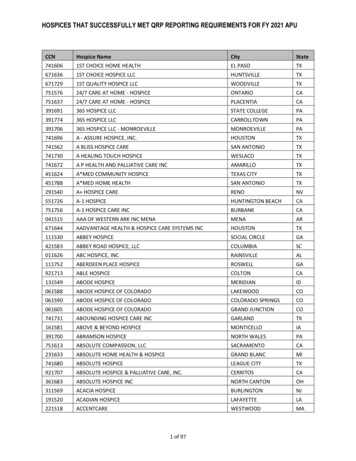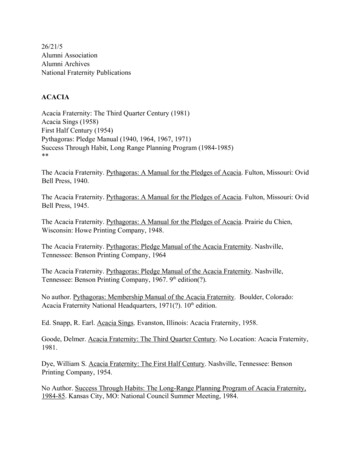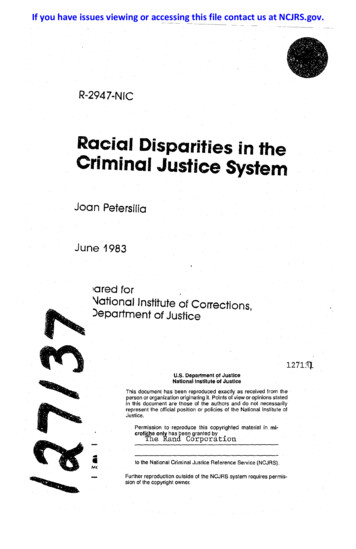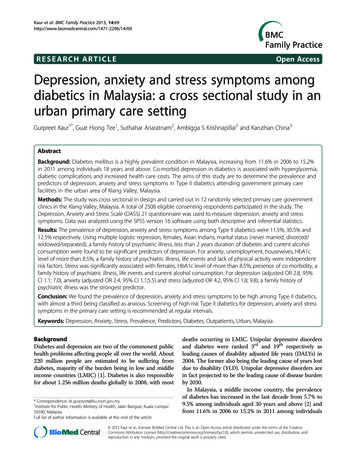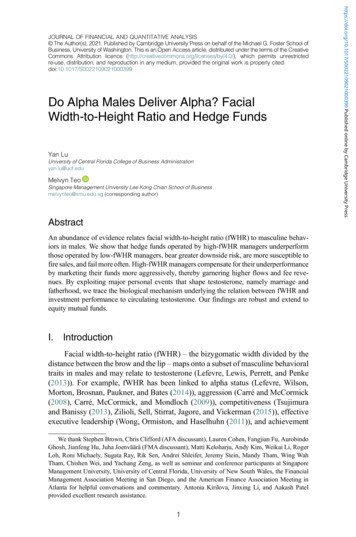
Transcription
Do Alpha Males Deliver Alpha? FacialWidth-to-Height Ratio and Hedge FundsYan LuUniversity of Central Florida College of Business Administrationyan.lu@ucf.eduMelvyn TeoSingapore Management University Lee Kong Chian School of Businessmelvynteo@smu.edu.sg (corresponding author)AbstractAn abundance of evidence relates facial width-to-height ratio (fWHR) to masculine behaviors in males. We show that hedge funds operated by high-fWHR managers underperformthose operated by low-fWHR managers, bear greater downside risk, are more susceptible tofire sales, and fail more often. High-fWHR managers compensate for their underperformanceby marketing their funds more aggressively, thereby garnering higher flows and fee revenues. By exploiting major personal events that shape testosterone, namely marriage andfatherhood, we trace the biological mechanism underlying the relation between fWHR andinvestment performance to circulating testosterone. Our findings are robust and extend toequity mutual funds.I.IntroductionFacial width-to-height ratio (fWHR) – the bizygomatic width divided by thedistance between the brow and the lip – maps onto a subset of masculine behavioraltraits in males and may relate to testosterone (Lefevre, Lewis, Perrett, and Penke(2013)). For example, fWHR has been linked to alpha status (Lefevre, Wilson,Morton, Brosnan, Paukner, and Bates (2014)), aggression (Carré and McCormick(2008), Carré, McCormick, and Mondloch (2009)), competitiveness (Tsujimuraand Banissy (2013), Zilioli, Sell, Stirrat, Jagore, and Vickerman (2015)), effectiveexecutive leadership (Wong, Ormiston, and Haselhuhn (2011)), and achievementWe thank Stephen Brown, Chris Clifford (AFA discussant), Lauren Cohen, Fangjian Fu, AurobindoGhosh, Jianfeng Hu, Juha Joenväärä (FMA discussant), Matti Keloharju, Andy Kim, Weikai Li, RogerLoh, Roni Michaely, Sugata Ray, Rik Sen, Andrei Shleifer, Jeremy Stein, Mandy Tham, Wing WahTham, Chishen Wei, and Yachang Zeng, as well as seminar and conference participants at SingaporeManagement University, University of Central Florida, University of New South Wales, the FinancialManagement Association Meeting in San Diego, and the American Finance Association Meeting inAtlanta for helpful conversations and commentary. Antonia Kirilova, Jinxing Li, and Aakash Patelprovided excellent research 399 Published online by Cambridge University PressJOURNAL OF FINANCIAL AND QUANTITATIVE ANALYSIS The Author(s), 2021. Published by Cambridge University Press on behalf of the Michael G. Foster School ofBusiness, University of Washington. This is an Open Access article, distributed under the terms of the CreativeCommons Attribution licence (http://creativecommons.org/licenses/by/4.0/), which permits unrestrictedre-use, distribution, and reproduction in any medium, provided the original work is properly cited.doi:10.1017/S0022109021000399
drive (Lewis, Lefevre, and Bates (2012), He et al. (2019)). Despite the preponderance of aggressive and competitive behaviors observed among traders (Mallaby(2010), McDowell (2010), and Riach and Cutcher (2014)) and the trillions of assetsmanaged by investment managers, we know little about the implications of fWHRfor delegated portfolio managers. In this study, we fill this void by exploring therelation between fWHR and investment performance for male hedge fund managers.1The hedge fund industry provides a fertile ground for exploring the implications of facial width on investment management. As some of the most sophisticated investors in financial markets (Brunnermeier and Nagel (2004)), hedgefunds collectively managed US 3.31 trillion of assets by the end of the thirdquarter of 2020 iles/articles/2020.Q3.HFR GIR.pdf). The dynamic and relatively unconstrained strategieshedge funds employ, which often involve short sales, leverage, and derivativesmay appeal to high-fWHR managers given their aggressive nature (Carré andMcCormick (2008), Carré, McCormick, and Mondloch (2009)). Some highfWHR managers may also be drawn to the industry’s limited transparency andregulatory oversight, which imply opportunities for deception and unethicalbehavior (Haselhuhn and Wong (2012), Geniole, Keyes, Carré, and McCormick(2014)). Anecdotal evidence suggests that in the male-dominated hedge fundindustry, attributes associated with fWHR, such as aggression, competitiveness,and physical prowess, are often synonymous with professional success(Mallaby (2010)).2 Moreover, unlike mutual funds, hedge funds are typicallymanaged by their founder-owners. Therefore, by focusing on hedge funds asopposed to mutual funds, we sidestep concerns related to endogenous matchingbetween firms and managers.Our analysis reveals substantial differences in expected returns on decileportfolios of hedge funds sorted by fund manager fWHR. Hedge funds operatedby high-fWHR managers underperform those operated by low-fWHR managers byan economically significant 4.43% per year (t-stat 5.12) after adjusting forco-variation with the Fung and Hsieh (2004) 7 factors. The inferior performanceof high-fWHR managers is not confined to small funds and cannot be traced to fundshare restrictions and illiquidity (Aragon (2007), Sadka (2010)), incentives1We focus on male managers as fWHR better predicts aggressive behaviors for men than for women(Carré and McCormick (2008), Carré, McCormick, and Mondloch (2009)). According to Lefevre et al.(2013), since women have higher levels of estrogen and growth hormone, which can also influence bonegrowth (Juul (2001)), facial morphology in men and in women likely reflect different growth andendocrine mechanisms and are thus not easily comparable. Consistent with this view, we show thatour results do not apply to female hedge fund managers. We note that the overwhelming majority ofhedge fund managers are males.2For example, Steve Cohen of SAC Capital and Point72 Asset Management has been described byex-employees as a driven, aggressive, and ruthless trader that presides over a “testosterone-charged”trading floor. See “Inside SAC’s shark tank,” Alpha, Mar. 1, 2010. According to Mallaby ((2010),p. 111), “to thrive at Julian Robertson’s Tiger Management, you almost needed the physique; otherwiseyou would be hard-pressed to survive the Tiger retreats, which involved vertical hikes and outwardbound contests in Idaho’s Sawtooth Mountains.” The short-seller, Jim Chanos of Kynikos Associates,bench-presses 300 lbs. See “Jim Chanos on bench-pressing, short selling, and the importance ofimmigration,” Square Mile, Oct. 12, 2017.https://doi.org/10.1017/S0022109021000399 Published online by Cambridge University Press2 Journal of Financial and Quantitative Analysis
(Agarwal, Daniel, and Naik (2009)), fund age (Aggarwal and Jorion (2010)), fundsize (Berk and Green (2004)), return smoothing behavior (Getmansky, Lo, andMakarov (2004)), and backfill bias (Fung and Hsieh (2009), Bhardwaj, Gorton, andRouwenhorst (2014)).We show that the behavioral traits that map from facial width can shape tradingbehavior and lead to suboptimal decisions. High-fWHR fund managers trade moreactively, have a stronger preference for lottery-like stocks, and are more likely tosuccumb to the disposition effect. These findings are broadly consistent with priorstudies that relate fWHR to aggression (Carré and McCormick (2008), Carré,McCormick, and Mondloch (2009)) and competitiveness (Tsujimura and Banissy(2013)).3 In line with the findings of Odean (1998) and Bali, Cakici, and Whitelaw(2011), high-fWHR managers’ preference for lottery-like stocks and reluctance tosell loser stocks in turn engenders underperformance.Haselhuhn and Wong (2012) and Geniole et al. (2014) show that fWHRpredicts unethical behavior among men. For hedge funds, unethical behavior canlead to greater operational risk (Brown, Goetzmann, Liang, and Schwarz (2008),(2009), (2012)). In keeping with this view, high-fWHR managers disclose moreregulatory actions as well as civil and criminal violations on their Form ADVs.They are also more likely to terminate their funds, even after controlling for pastperformance. Moreover, hedge funds managed by high-fWHR managers exhibithigher ω-Scores, a univariate measure of operational risk (Brown et al. (2009)). Dohigh-fWHR managers also take on more investment risk? While high-fWHR fundsdo not deliver more volatile returns, their returns feature greater downside deviations, higher downside betas, steeper maximum losses, and sharper maximumdrawdowns, suggesting that they bear more left tail risk.Given their aggressive and competitive tendencies, high-fWHR managersmay take on excessive liquidity risk relative to their share restrictions. The resultantasset-liability mismatch should precipitate asset fire sales and purchases (Coval andStafford (2007)) when investors redeem from and subscribe to high-fWHR funds,respectively. We find precisely this result. Relative to low-fWHR funds, highfWHR funds bear more liquidity risk but offer better redemption terms to theirinvestors. Moreover, for high-fWHR funds, those that experience strong inflowssubsequently outperform those that experience strong outflows by an annualized5.88% (t-stat 2.32) in the following month, after adjusting for co-variation withthe Fung and Hsieh (2004) factors. For low-fWHR funds, the correspondingspread is only 0.20% per annum (t-stat 0:08). Consistent with the fire salesand purchases view, the abnormal spread return from the flow sort withhigh-fWHR funds is substantially higher when the Pástor and Stambaugh(2003) liquidity measure is low and funding liquidity, as measured by the Treasury–Eurodollar spread and aggregate hedge fund flows, is tight.Facial width has been associated with greater achievement drive amongU.S. presidents (Lewis, Lefevre, and Bates (2012)) and Chinese sell-side analysts(He, Yin, Zeng, Zhang, and Zhao (2019)). For hedge funds, achievement drivetranslates into intensive capital raising. After controlling for the usual suspects,3Competitiveness may be related to the disposition effect as competitive individuals could simplyhate to lose and therefore be more averse to losses.https://doi.org/10.1017/S0022109021000399 Published online by Cambridge University PressLu and Teo 3
we find that high-fWHR managers attract more unconditional flows. They do soby reporting to more commercial hedge fund databases, offering more duplicateshare classes, and participating in more hedge fund conferences, thereby loweringinvestor search and entry costs. Consequently, high-fWHR managers operatelarger funds and harvest greater fee revenues. These results help rationalizewhy such managers can survive despite underperforming their competitors.Our results are consistent with the vector of behavioral traits that maps fromfWHR. What is the underlying biological mechanism that links fWHR to suchbehavioral attributes? The circulating testosterone hypothesis postulates that fWHRrelates positively to baseline and reactive testosterone levels in men. Consistentwith this hypothesis, Lefevre et al. (2013) show that fWHR positively relates tosaliva-assayed testosterone for men before and after mate exposure. This hypothesisis, however, still open to debate (Bird, Jofré, Geniole, Welker, Zilioli, Maestripieri,Arnocky, and Carré (2016)). A companion view, the pubertal testosterone hypothesis, posits that fWHR’s association with behavioral traits is tied to testosteroneexposure in puberty, rather than to baseline or reactive testosterone in adulthood(Weston, Friday, and Liò, (2007), Welker, Bird, and Arnocky (2016)). To investigate whether testosterone drives our findings, we reestimate our baseline regressions with 2 alternative biomarkers for testosterone in place of fWHR. We find thatmanagers with larger values of face width-to-lower face height and smaller valuesof lower face height-to-whole face height, which Lefevre et al. (2013) show arelinked to higher levels of salivary testosterone, also underperform. These results aremost consonant with the circulating testosterone view.4This study is not immune to endogeneity concerns. For example, we need toentertain the possibility that people may stereotype broad-faced men as aggressiveand deceptive, which in turn could nurture the expected behavior in these men.Alternatively, facial width could positively relate to facial adiposity and, therefore,negatively related to manager self-discipline. To address such concerns and furtherinvestigate the testosterone view, we take advantage of two major personal eventsthat lead to sharp declines in testosterone levels for men: marriage and fatherhood.Evidence from endocrinology suggests that marriage (Mazur and Michalek (1998),Holmboe, Priskorn, Jørgensen, Skakkebaek, Linneberg, Juul, and Andersson (2017))and fatherhood (Berg and Wynne-Edwards (2001), Gettler, McDade, Feranil, andKuzawa (2011)) suppress circulating testosterone levels in males. Under the circulating testosterone view, such events should disproportionately impact high-fWHRmanagers given their higher reactive levels of testosterone. Testosterone suppression should also be greater for high-fWHR men in light of their higher baselinelevels of testosterone and the findings of Berg and Wynne-Edwards (2001) whoshow that men with higher basal testosterone are more likely to experience testosterone depletion post-birth. Consistent with this view, we find that marriage andfatherhood substantially attenuate the underperformance of high-fWHR managersrelative to low-fWHR managers. In line with prior work showing that testosterone4These results do not necessarily imply, given the lower circulating testosterone levels of females,that female hedge fund managers outperform male hedge fund managers. Females differ from males inother ways that could also affect performance. For instance, females tend to have higher levels ofestrogen than do males and it is not clear how estrogen affects investment 399 Published online by Cambridge University Press4 Journal of Financial and Quantitative Analysis
suppression is greater for newly partnered men and fathers with young children, ourresults are stronger for precisely such fund managers. The findings are not driven bymarriage and fatherhood affecting the relative performance of high- versus lowfWHR managers for reasons, such as limited attention and performance persistence,that are unrelated to testosterone. These results bolster the circulating testosteroneview and provide insights into the biological mechanism relating fWHR to fundmanager behavior.We carefully consider and rule out several alternative explanations, includingsample selection, sensation seeking, biological age, manager race, barriers to entry,overconfidence, and endogenous matching between managers and hedge fundfirms. To adjust for sample selection, we employ the Heckman (1979) 2-stageprocedure with firm strategy flow at inception as the exclusion restriction and findthat the negative relation between fWHR and fund performance is even strongerafter adjusting for possible sample selection bias. Our choice of exclusion restriction follows Asker, Farre-Mensa, and Ljungqvist (2015) and is robust to alternative specifications. The results are robust to controlling for sensation seekingusing speeding tickets (Grinblatt and Keloharju (2009)) and sports car ownership(Brown, Lu, Ray, and Teo (2018)). To address any endogenous matching concerns,we control for fund management company fixed effects. We also redo the baselineregressions on the first funds of hedge fund firms, as firm founders are more likely torun such funds. None of our inferences change with these adjustments.To test whether our findings extend beyond hedge funds, we redo the performance sorts and regressions on actively managed U.S. equity mutual funds. We findthat mutual funds in the top fWHR decile underperform mutual funds in thebottom fWHR decile by a substantive 8.80% per annum (t-stat 20.89) afteradjusting for co-variation with the Carhart (1997) 4 factors. Inferences remainunchanged when we account for other fund characteristics that could explainmutual fund performance, analyze style-adjusted mutual fund performance, studypre-fee mutual fund returns, or evaluate mutual fund performance relative to theFama and French (2016) 5-factor model. The greater underperformance ofhigh- versus low-fWHR mutual funds relative to hedge funds is consistent withthe self-selection biases inherent in hedge fund data (which are absent in mutualfund data) that could limit the number of return observations associated withextreme-fWHR hedge funds.The findings deepen our understanding of fund manager skills. The resultsreveal that, just like motivated (Agarwal, Daniel, and Naik (2009)), emerging(Aggarwal and Jorion (2010)), low R2 (Titman and Tiu (2011)), talented (Li,Zhang, and Zhao (2011)), and distinctive (Sun, Wang, and Zheng (2012)) hedgefunds, those operated by managers with lower fWHR also outperform. This studyalso complements research in delegated portfolio management that relate to managercollege selectivity (Chevalier and Ellison (1999)), confidence (Bai, Ma, Mullally, andSolomon (2019)) and Ph.D. training (Chaudhuri, Ivković, Pollet, and Trzcinka(2020)) to investment performance. Unlike the aforementioned studies, we uncovera biological component of managerial skill.This article builds on an emerging literature that examines the associationbetween fWHR and financial outcomes. It finds that CEOs with high fWHR deliverhigher return on assets (Wong, Ormiston, and Haselhuhn (2011)), are more likely tohttps://doi.org/10.1017/S0022109021000399 Published online by Cambridge University PressLu and Teo 5
engage in financial misreporting (Jia, van Lent, and Zeng (2014)), and take on morerisk (Kamiya, Kim, and Park (2019)). We enrich this literature by analyzing theimplications of fWHR for delegated portfolio managers and in the process provideinsights into important issues such as behavioral biases, operational risk, downsiderisk, asset-liability mismatch, and marketing intensity. Our identification strategyaddresses the shortcoming of this stream of research whereby the relation betweenfWHR and testosterone is often assumed but not assessed. In a related work, Heet al. (2019) find that Chinese sell-side analysts with higher fWHRs issue moreaccurate earnings forecasts and ascribe their results to achievement drive. Ourfindings suggest that achievement drive may not be the dominant trait encapsulatedby fWHR at least in the context of asset management. While high-fWHR fundmanagers raise more capital, which is consistent with greater achievement drive,they are also more susceptible to behavioral biases and bear greater downside risks.Consequently, they earn lower investment returns and alphas.This study also resonates with work on testosterone and individual investor trading behavior. Research has shown in experimental settings that hightestosterone men overbid for assets (Nadler, Jiao, Johnson, Alexander, and Zak(2018)) and take on more risk (Apicella, Dreber, Campbell, Gray, Hoffman, andLittle (2008)). In addition, Cronqvist, Previtero, Siegel, and White (2016) showthat among fraternal twins, females with higher prenatal testosterone exposureinvest more in equities, hold more volatile portfolios, trade more often, and loadmore on lottery-like stocks. However, none of these papers investigate investmentperformance. Our work is related to Coates and Herbert (2008) and Coates,Gurnell, and Rustichini (2009) who show that high-testosterone intraday tradersoutperform. Nonetheless, it is difficult to generalize their results to investmentmanagement given their limited sample sizes (17 and 44 traders, respectively)and the fact that the skills prized in intraday or noise trading (i.e., rapid visuomotor scanning abilities and sharp physical reflexes) may not be relevant forthe more analytical forms of trading commonly employed by money managers.5Moreover, they do not control for risk. Our results suggest that testosterone isless beneficial for delegated portfolio managers. The findings dovetail withlaboratory studies that show that testosterone can lead individuals to makeirrational risk-reward tradeoffs (Reavis and Overman (2001), van Honk, Schutter,Hermans, Putnam, Tuiten, and Koppeschaar (2004), and Nave, Nadler, Zava, andCamerer (2017)).The remainder of this article is structured as follows: Section II reviews theevidence relating fWHR to behavioral traits and testosterone in males anddescribes the data. Section III reports the empirical results. Section IV presentsrobustness tests while Section V investigates equity mutual funds. Section VIconcludes.5Unlike the intraday traders in the aforementioned studies, who typically hold their positions for onlya few minutes, sometimes mere seconds, hedge fund managers often take more time to analyze theirpositions and hold their trades for weeks, months, and even years (Perold (2003), Cohen and 21000399 Published online by Cambridge University Press6 Journal of Financial and Quantitative Analysis
II.Data and MethodologyA.Testosterone, Behavior, and fWHRResearch has shown that fWHR relates to aggression, physical prowess,achievement drive, risk-taking, and deception in males. Carré and McCormick(2008) find that among both varsity and professional male hockey players, fWHRpositively relates to aggressive behavior as measured by the number of penaltyminutes per game incurred over a season. In a meta-analysis, Haselhuhn, Ormiston,and Wong (2015) demonstrate a robust positive link between fWHR and aggressionin men. With respect to physical prowess, fWHR is associated with home runperformance among professional Japanese baseball players (Tsujimura and Banissy(2013)) and fighting ability among professional mixed martial artists (Zilioli et al.(2015)). Moreover, fWHR is consonant with greater achievement drive for U.S.presidents (Lewis, Lefevre, and Bates (2012)) and for Chinese sell-side analysts(He et al. (2019)). It also predicts risk-taking behavior, albeit only for low-statusmen (Welker, Goetz, and Carré (2015)). However, Haselhuhn and Wong (2012)find that wide-faced men are also more likely to deceive their counterparts in anegotiation, and cheat to increase financial gain.Testosterone has been proposed as the biological construct that relates fWHRto such behaviors in males. The exact mechanism by which testosterone relatesto fWHR is still open to debate. The pubertal testosterone hypothesis posits thattestosterone is responsible for the development of both facial bone structure andneural circuitry during puberty for males (Weston, Friday, and Liò (2007)), and it isthe change in neural circuitry during adolescence that drives behavior in adulthood.Consistent with this view, Verdonck, Gaethofs, Carels, and de Zegher (1999) findthat low doses of testosterone accelerate craniofacial growth among boys withdelayed puberty. Lindberg, Vandenput, Movèrare Skrtic, Vanderschueren, Boonen,Bouillon, and Ohlsson (2005) and Clarke and Khosla (2009) document the relationbetween testosterone and bone growth. Morris, Jordan, and Breedlove (2004) showthat testosterone masculinizes the developing nervous system, thereby promotingmale behaviors. Similarly, Sisk, Schulz, and Zehr (2003) find that testosteronedependent organization of neural circuits underlying male social behavior occursduring puberty. While Hodges-Simeon, Sobraske, Samore, Gurven, and Gaulin(2016) show that fWHR does not relate to testosterone for a sample of 75 adolescentTsimane males, they do not control for age and adopt a liberal criterion foradolescence (i.e., ages 8–23 years). After controlling for age and limiting theTsimane sample to adolescent males between 12 and 16 years old, Welker, Bird,and Arnocky (2016) document a strong and positive relation between fWHR andpubertal testosterone.A companion view, the circulating testosterone hypothesis, postulates thatfWHR relates to baseline and reactive testosterone levels in adulthood, which inturn shapes behavior. In line with this view, Lefevre et al. (2013) find that fWHR ispositively associated with salivary testosterone in males both before and after aspeed dating event. Moreover, testosterone relates to financial risk-taking (Apicellaet al. (2008)), aggression (Batrinos (2012)), social dominance (Mehta, Jones, andJosephs (2008)), and egocentrism (Wright, Bahrami, Johnson, Di Malta, Rees, Frith,https://doi.org/10.1017/S0022109021000399 Published online by Cambridge University PressLu and Teo 7
and Dolan (2012)), attributes that are also predicted by fWHR. Several studiesshow that circulating testosterone modulates social behavior through the amygdala,the part of the brain that is primarily involved in processing emotions (includingfear, anxiety, and aggression). For instance, Radke, Volman, Mehta, van Son, Enter,Sanfrey, Toni, de Bruijn, and Roelofs (2015) show using functional magneticresonance imaging that testosterone administration increases amygdala responseto social threat approach. Bos, Terburg, and van Honk (2010) argue that theamygdala responds to testosterone by reducing communication with the orbitofrontal cortex and activates the brainstem defense circuit, which leads to aggressive behavior in the face of a social threat. In a challenge to the circulatingtestosterone view, Bird et al. (2016) find no significant positive relation betweenfWHR and baseline testosterone or competition-induced testosterone reactivity intheir meta-analysis. However, unlike Lefevre et al. (2013), Bird et al. (2016) arenot able to control for age and body mass index, which can also affect testosterone(Feldman, Longcope, Derby, Johannes, Araujo, Coviello, Bremner, and McKinlay(2002), Diaz-Arjonilla, Schwarcz, Swerdloff, and Wang (2009)). Moreover, Birdet al. (2016) focus on video game competitions, which unlike speed dating events donot feature mate exposure and where the payoffs may not be large enough to elicit asignificant testosterone reaction. Jia, van Lent, and Zeng (2014) provide an excellentreview of literature relating fWHR to behavior and testosterone.B.Hedge Fund and fWHR DataWe evaluate the relation between manager fWHR and hedge fund performance using monthly net-of-fee returns and assets under management (AUM)data of live and dead hedge funds reported in the Lipper TASS, Morningstar,Hedge Fund Research (HFR), and BarclayHedge data sets from Jan. 1994 to Dec.2015. We focus on data from Jan. 1994 onward as the hedge fund data sets containsurvivorship bias prior to Jan. 1994.In our fund universe, we have a total of 38,084 hedge funds, of which 14,869are live funds and 23,215 are dead funds. Due to concerns that funds with multipleshare classes could cloud the analysis, we exclude duplicate share classes from thesample. This leaves a total of 22,071 hedge funds, of which 8,135 are live funds and13,936 are dead funds. While 5,564 funds appear in multiple databases, many fundsbelong to only one database. Specifically, there are 5,635, 2,653, 4,383, and 3,836funds unique to the Lipper TASS, Morningstar, HFR, and BarclayHedge databases,respectively, highlighting the advantage of obtaining data from multiple sources.For each manager in the combined database, we use manager name and fundmanagement company name to perform a Google image search for the manager’sfacial picture or pictures.6 If we find multiple pictures of the manager, we identifythe best photograph in terms of resolution, whether the manager is forward facing,and whether he has a neutral expression. We follow Carré and McCormick (2008)6We obtain manager photos from investment management company websites, manager LinkedInprofiles, investment conference web pages, high society websites, news articles, and social media. Onseveral occasions, we are able to find manager photos even when the manager has moved to another firmor has shut down his fund by searching for his current place of employment listed on his LinkedIn orBloomberg profile.https://doi.org/10.1017/S0022109021000399 Published online by Cambridge University Press8 Journal of Financial and Quantitative Analysis
and manually measure fWHR using the ImageJ software provided by the NationalInstitute of Health (Rasband (2018)). As per Carré and McCormick (2008), wedefine the measure as the distance between the 2 zygions (bizygomatic width)relative to the distance between the upper lip and the midpoint of the inner endsof the eyebrows (height of the upper face).7 As discussed, we focus on male managersin our analysis. We do so by searching for the facial images of all managers and thenexcluding female managers from the sample by using manager name and facial imageto determine gender. To address reproducibility concerns, we will redo our analysiswith fWHR computed via a Python program as a robustness test.Since measurement error can creep into the computation of fWHR if themanager is not fully forward facing or has significant facial adiposity around thecheek area, we exclude managers from the sample who are not fully forward facingin their photographs or who are in the top 10th percentile based on a subjectiveassessment of their facial adiposity.8 In total, we obtain valid photos and computefWHRs for 2,446 male fund managers. These managers operate 2,629 hedge fundsand belong to 1,484 fund management companies. In this study, we use fundfWHR, defined as the average fWHR of the managers operating a hedge fund, asa proxy of the level of manager fWHR associated with a hedge fund.9Following Agarwal, Daniel, and Naik (2009), we classify funds into 4 broadinvestment styles: Security Selection, Multi-process, Directional Trader, andRelative Value. Security Selection funds take long and short positions in undervalued and overvalued securities, resp
The Heckman (1979) selection model is used to control for selection bias in regressions on the cross-section of hedge fund performance. The dependent variables in Table 10 include RETURN and ALPHA where RETURN is the monthly hedge fund net-of-fee return and ALPHA is the Fung and Hsieh (2004) monthly alpha with factor loadings estimated over the .





